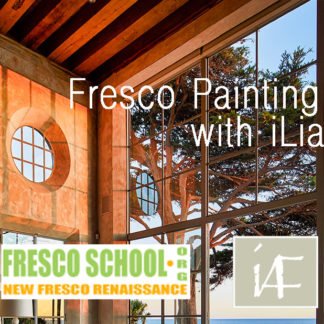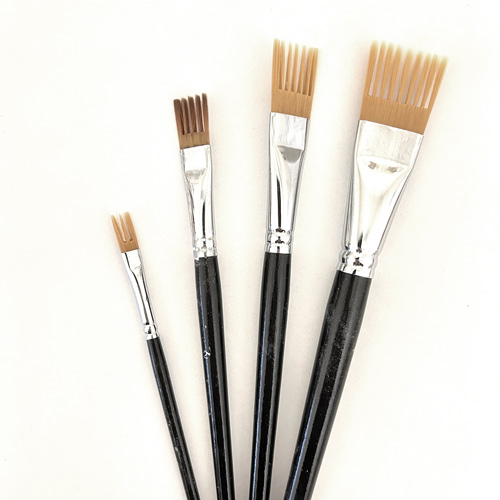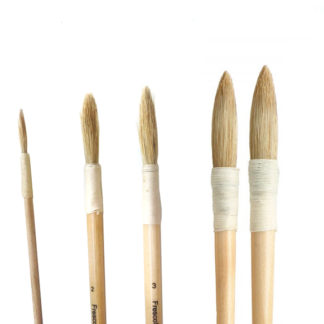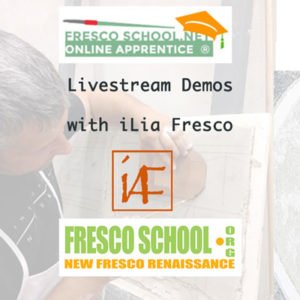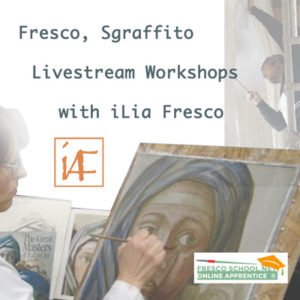What is Fresco?
Affresco ( In English usage, “fresco” ), Buon Fresco (true fresco). Painting done on freshly laid wet plaster with pigments dissolved in lime water. As both dry they become completely integrated.
In true fresco (ital. – buon fresco) the artist must start applying his colors on the wet (or fresco) intonaco as soon as it has been prepared and laid on the wall. The colors can thus be absorbed by the wet plaster. When it dries and hardens, the colors become one with plaster.
Technically speaking the plaster does not “dry” but rather a chemical reaction occurs in which calcium carbonate is formed as a result of carbon dioxide from the air combining with the calcium hydrate in the wet plaster.
In it’s essence, fresco or fresco painting is an – application of natural mineral pigments to a surface on which a following chemical reaction takes place:
Ca(OH)2(s) + CO2(g) —-> CaCO3(s) + H2O(l)
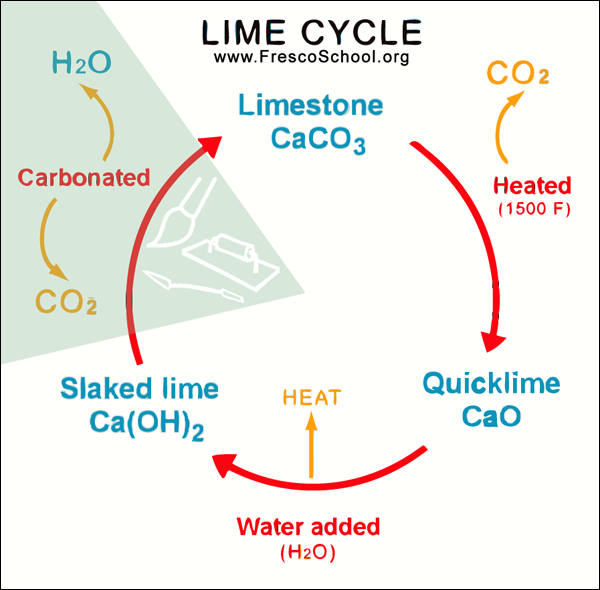
Calcium Hydrate (burned lime stone or marble mixed with water also called calcium hydroxide) combined with carbon dioxide resulting in the formation of Calcium Carbonate – lime stone, marble. The pigment gets trapped within the newly formed calcite crystal. It is like “Painting with molten Marble”.
Those elements naturally surround people from the beginning of time. Calcium Hydrate – moist lime stone walls of the caves at first and plastered walls and ceilings of the buildings later. Paints prepared from natural pigments made of minerals, earth oxides and clays and mixed with water. Painting in Fresco results in a painting being a part of the newly formed stone/wall rather than being a “film on a surface”.
This fact makes fresco the only pure, “organic” or “green” method of painting – no solvents, glues or man-made (synthetic) materials are used. It is also most permanent method of painting which will not fade, flake off, etc. The aged crumbling look of old frescoes is a result of the damage to the wall surface, not the painting failure. Recently cleaned frescoes by Michelangelo in the Sistine Chapel are great example of the permanence of the medium.
Fresco painting is a direct product of the desire of our species to communicate by visual means when the “words are not enough or do not yet exist” and a desire to “leave a mark”. It is a “Primal Graffiti” of our ancestors (wall paintings in Neolithic limestone caves) that have evolved into the Grand medium of the Empires and Nations. With earliest known examples from over 40,000 ago, fresco painting is the most practiced method of painting present in every culture and utilized by every known civilization for decorating of the most treasured environments, palaces, public places.
It is said that fresco painting is the logical link between architecture and decoration. During the Renaissance Fresco was regarded to as “The Mother of All Arts”. This statement is as relevant today as it was then. Every culture and it’s painting in particular is greatly influenced by fresco. Prior to “printing age” public buildings and common places, decorated with the wall paintings (frescoes), were the only sources from which people, and artists specifically, could learn about current painting techniques and styles. The art techniques of the past – unearthed painting of Pompeii that survived centuries underground due to being true frescoes is just one example of that.
Visual reference provided by Frescoes led to overall development and refinement of the painting, drawing and composition techniques themselves. The magnificent frescoes of the Renaissance are the great example of the levels to which fresco painting has enabled artists to refine the art of painting. In fresco the artist has relatively short period of time to complete the painting. The painting must be done while the chemical reaction is taking place, which is generally 6-12 hours (large works are done in sections proportionate to the area that can be completed in a day).
Fresco is a challenging medium – it does not allow for errors or corrections which require adequate level of the artistic and technical skill. Due to this fact paintings done in fresco are mainly created by the most significant artists of the time and consequently found in the most treasured environments. Being present in our lives from “the beginning of time” fresco paintings became the most recognized works of art throughout the world. Every culture and every nation does identify with the monuments of the past as their cultural roots. If the monument carries a painting it is most likely a fresco simply because that will be almost a requirement to last through the centuries or millennia.
Start your Fresco Painting Journey – Join Fresco School, Get FS Membership!

